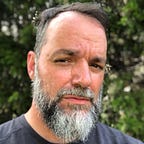A functional description of life, virtual and otherwise.
Today, there are are many digital entities that seem to exhibit behaviors that, if they existed in the real world, we would say made them look alive.
This got me to thinking something along these lines: Life began once, as far as we know, and hasn’t ended since. If you project time into a spatial dimension, then the temporal act of reproduction, or copying, becomes a shape: a branch. Eventually that branch comes to an end — an organism dies. Sometimes before the branch dies, it reproduces, throwing off one or more other branches itself.
Viewed in this way, everything that is alive or ever has been alive is a node on a single large “tree of life”. Observations that we are all part of a greater whole go from being the province of philosophers to being a simple mathematical description of the only organism that has ever existed.
The way that life reproduces itself has undergone fundamental transformation at several points, and continues to do so today. Sexual reproduction was a fundamentally different method of reproducing — of branching — than what came before. Viral reproduction, which hijacks the reproductive machinery of a physically adjacent organism, is another.
We created the digital world, and we created everything in it. If digital things can live, then it is because we gave them life. Perhaps the creation of the digital world is just another fundamental transformation of the way that life reproduces itself.
If digital things are alive, then they are descended from our physical selves. We created them. Are digital beings fundamentally different than physical ones? I think perhaps they are not. And this goes to the question of, what, fundamentally, life is.
Many definitions of life are descriptive, in that they start with a universe of things perceived to be alive — plants, animals, viruses — and try to define life by what these different living things have in common. They’re very valid an important definitions of life, but they describe what life does, without addressing why it does those things, and it is incapable of describing forms of life that do not yet exist.
I began to wonder if I could construct a definition of life that is functional — that describes what it does, rather than what it looks like — and whether such a description of life could encompass both physical beings and digital ones. Here my best attempt at one so far:
Life is an entropy pump, that operates at larger scales over time through self-similarity — -by making copies of itself. It is Maxwell’s Demon, powered (usually though not necessarily) by the sun. A cell divides the world into two spaces, and does work to keep the inside more ordered than the outside.
All life is more complex and ordered than its environment. The fundamental aspect of it is that it is a configuration of matter that uses energy from its environment to create order. It pushes back on the arrow of time. This pushback is work. It requires energy, which must come from the environment. To date, all the energy that life depends on comes from the temperature differential between the earth and the sun.
If we look at it spatially, then we can describe life as an extent of time space with an observable branching structure, characterized by lower levels of entropy than the surroundings. To me, this description of it makes the fractal nature of life, of its patterns of self-similarity, easier to understand.
But there is a fundamental and established relationship between the physical concept of entropy and the virtual concept of information, so it should be possible to restate this definition of life in virtual terms:
Life is an information pump that operates at larger scales over time through self-similarity — by making copies of itself. It is Maxwell’s decision process, powered, still, essentially and indirectly, by the sun. Life divides the world into two sets, and orders the content of one of them.
Would a notional sentient digital being perceive itself as fundamentally separate from the organic life that created it? I think probably it would not, and it would be right. This doesn’t necessarily tell us much about how we would relate to such an entity, of course — the tree of life is infamous for its self-pruning! — but it does give us framework for thinking about how such a being might regard us.
After writing this I became aware of Erwin Schrödinger’s 1944 book What is Life? which includes as one of its premises a very similar definition of life. However, this is only an opening gambit in his “physicist’s theory of life”, which would go on to influence Crick and Watson in their search for the carrier of genetic information.
